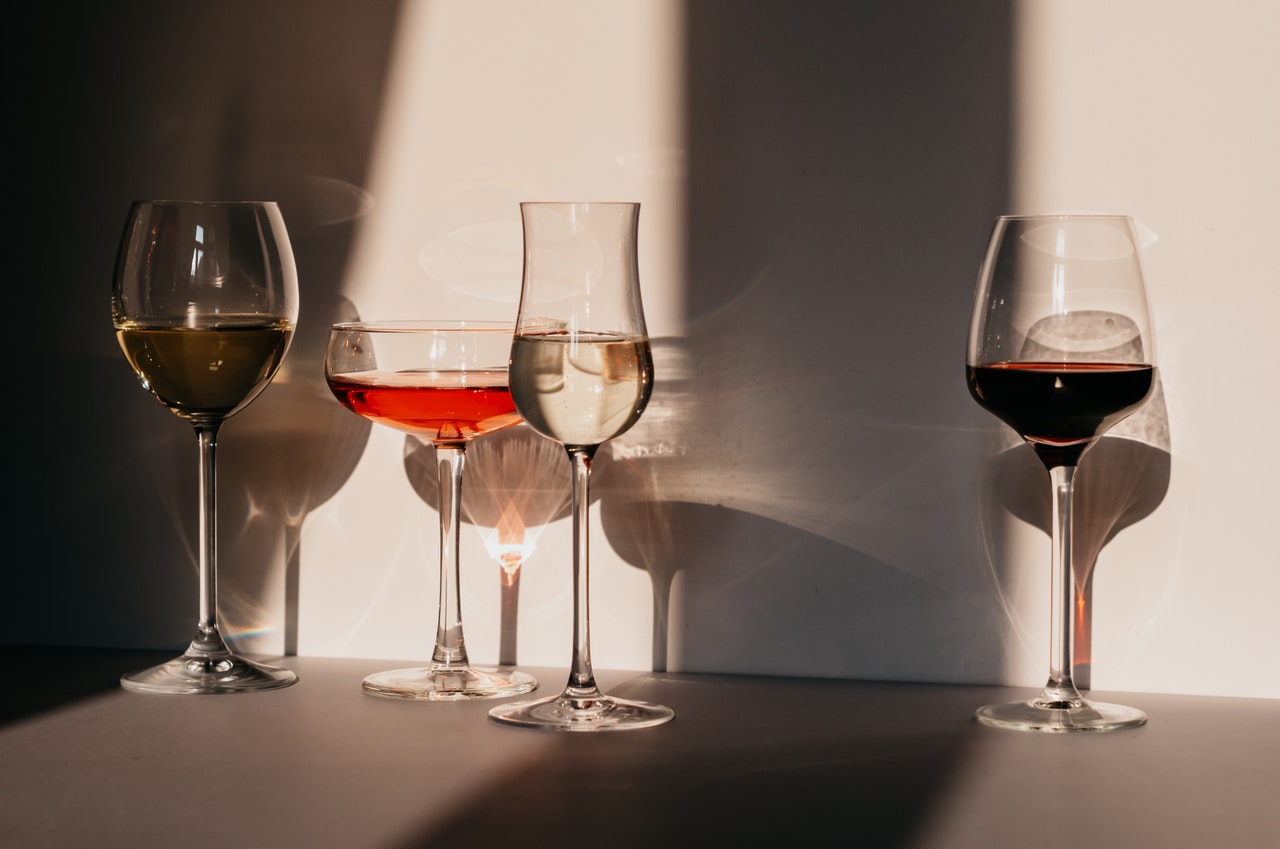Have you ever found yourself confused with all the different wine glasses? Is it only a matter of preference or does the wine glass you choose actually matter?
Spoiler alert: It does matter.
In this guide, we'll discuss wine glasses 101, specifically how the shape and style of a glass can influence the taste of your wine. Let's dive into the wonderful world of wine glasses and how to choose the right one, shall we?
Why Does the Type of Wine Glass Matter?
There's practically a specific glass for every type of wine, from Chardonnay to Champagne. There are over 200 types of wine glasses, and counting. Do you need a glass for every type of wine you plan to drink? No. But should you invest in specific glassware for the wines that you regularly imbibe? Absolutely. Here's why:
From rounded bowls to narrow flutes, each type of glass was specifically created to bring out the unique character of the wine it's named after. Some argue that drinking wine from the wrong glass can dramatically alter its taste.
Can you drink Sauvignon Blanc out of a red SOLO cup? Sure. But will it taste the same as it would from a standard white wine glass? Probably not. The slender U-shaped bowl found in a standard white wine glass allows your nose to detect the delicate fruity or floral aromas. This enhances the taste of your wine.
Or consider this angle (literally):
The shape of a glass' bowl and rim impact the flow of wine. If you like to savor your wine as it gently glides across the palate, you need a glass with a thin rim. This creates an elegant and easy sip.
When it comes to the perfect wine tasting experience, everything plays a role, from the temperature of the wine to the food that you pair with it. It follows that the glass you choose will play a role in the tasting experience. This is why you must choose your glass wisely. Let’s now discuss what you should consider when choosing the perfect wine glass.

The Four Parts of a Wine Glass
A wine glass has four parts. Let's examine each and how they influence the taste and enjoyment of wine.
Base - Also known as the foot, the base of the glass is created with stability in mind. It’s used to hold the glass upright. The perfect wine glass has a wide enough base to prevent it from tipping over, but not so wide that it’s hard to fit on a table. You can also hold a stemmed wine glass at its base.
Stem - The stem is the part of the glass that connects the bowl to the base. It gives you a way to hold the glass without heating up the temperature of the wine. It also prevents you from smudging the glass with fingerprints.
Bowl - The bowl is the part of the glass that holds the wine. Its shape will determine how you experience the wine's aroma. Large bowls allow the wine to be exposed to the air. Air oxidizes the wine, which smooths it out and creates a more pleasant taste. That’s important for red wines that tend to be bitter if not properly aerated. However, white wines fare better with smaller bowls because they don’t need to be exposed to air like reds do.
Rim - The rim is the tip of the glass. It can be shaped inward or outward. It's the part of the glass that comes in contact with your lips and is in fact called the mouth of the glass. The thinner the rim, the less it interrupts the flow of the wine from the glass to the lips. A thick rim, especially one that’s rolled, will not only prevent the smooth flow of wine, but it can also produce a harsher taste.
Also note that when pouring wine, specifically red wine, the liquid should never be filled to the top. It’s important for the glass to have headspace. Headspace is the empty area of the wine glass between the liquid and the rim. It allows you to swirl the wine and properly open its aroma.
The shape of the glass isn't the only factor that impacts taste and enjoyment. Glass thickness also matters. Glass that's thinner tends to have thinner rims, which allow for an even and steady flow.
Types of Red Wine Glasses

Now that we’ve gone over the basics, let’s get specific and focus on the most common types of red wine glasses.
Burgundy Wine Glass
The Burgundy wine glass has a broad bowl with a narrow top. It’s perfect for lighter and more delicate red wines like Beaujolais because the bowl allows the wine’s aroma to develop.
Cabernet Glass
The Cabernet wine glass is perhaps the most recognizable and commonly used type for red wine. It’s versatile and an excellent option if you’re looking for that one glass that you can use for multiple types of reds. In comparison to the Burgundy glass, the Cabernet glass is taller and slimmer. Its straight sides help to aerate the wine and bring out the wine’s flavor.
The Cabernet is often mistaken for the Bordeaux glass, but Cabernet is slightly taller. Both allow the wine to breathe, but Cabernet has a bigger rim that allows more oxygen in to further oxidize and smoothe out the taste.
This wine glass is perfect for full bodied wines that are spicy and even bitter. The larger bowl allows the red’s natural ethanol vapors to evaporate, which reduces tannins and softens the spiciness.
Pinot Noir Glass
The Pinot Noir glass is balloon shaped, which helps to balance the acidity and sweetness in the wine. This shape, with its rounded bowl and swooped top also lends itself to the sniff or swirl. The wine’s aroma is effectively carried up through the rim to present a flavor to the nose.
Types of White Wine Glasses

Let’s now discuss white wine glasses. While there are various types of white wines, we’ll only focus on the three most common types:
Standard White Wine Glass
Sometimes referred to as the Sauvignon Blanc glass, this type of glass is like a smaller Cabernet Sauvignon glass. It has straight, slightly tapered sides and a smaller bowl. It’s perfect for delicate and light white wines. The narrowness of the glass helps to preserve the white wine’s chill (whites should be served at a cooler temperature than reds).
Champagne Glass
The Champagne glass is one of the most recognizable wine shapes. It’s tall, slender, and leans inward. Its narrow shape helps to carry bubbles to the top of the rim. Unlike other wines, sparkling, Prosecco, or Champagne can be poured close to the rim.
Chardonnay Glass
Unlike the standard white wine glass, the Chardonnay glass has a large bowl and a wide mouth opening. This larger bowl enhances the floral aromas and acidity of a mature white wine.
Other Wine Glasses

In addition to the standard reds and whites, there are other wine glasses to consider adding to your selection, such as:
Coupe - This glass features a short stem and a large, wide bowl that allows for plenty of aeration. The Coupe is perfect for sweet champagnes like Prosecco and Cava.
Rosé - This glass has a long stem and a flared lip. The flared lip ensures that the wine meets the tip of tongue where the sweet taste buds live. This minimizes the harsh bite and enhances the wine’s sweetness.
Dessert - This type of glass is for dessert wines or wines that have been fortified with a spirit like Brandy to create a sweeter flavor. Dessert wine glasses are miniature in size. They have smaller bowls to discourage over-serving. They also have narrow mouths which help to concentrate the aroma of the wine.
The Case for Stemless
Stem or no stem?
There are a lot of reasons why you may want to go stemless.
The first reason is that the stemless look is modern and edgy. A wine glass without a stem goes against tradition.
Another reason to go stemless is for function. Stemless glasses are easy to store, come in a variety of shapes and sizes, and tend to be hardier than stemware.
And finally, one of the biggest reasons to go stemless is for mental health. Seriously. Holding a wine glass can cause a lot of anxiety. Some people feel self-conscious holding a glass by its stem, so when there’s no stem, there’s no worry.
Why should you avoid a stemless glass? Wine in stemless glasses tends to get warmer quicker because your hand comes in contact with the bowl and not the stem. But if you drink quickly enough, that shouldn’t be an issue.
Stem or no stem is truly up to you. There’s no right or wrong answer here. It’s truly the bowl that affects the taste, not the stem. And the good news is that you can get stemless bowls in the same shapes as stemmed glasses.
Choosing the Right Wine Glasses
Choosing your wine glass is almost as important as choosing your wine. The two go hand in hand. By choosing the right wine glass, you'll be able to experience the full taste and sensation that the wine offers.


